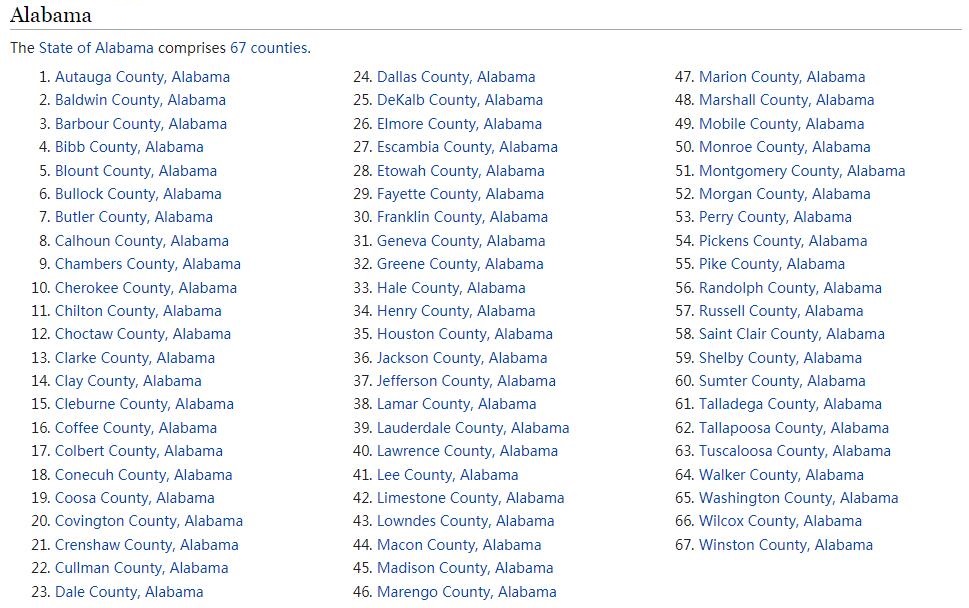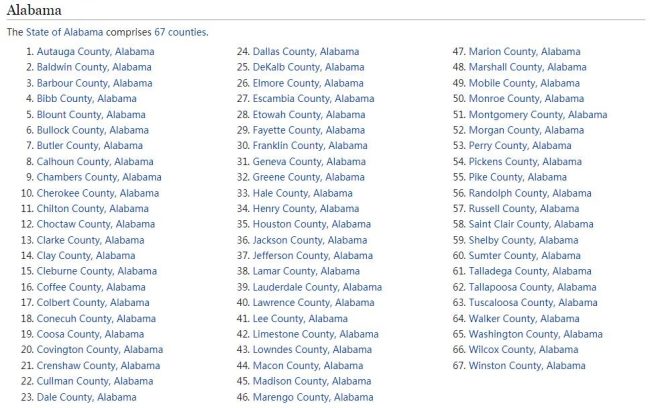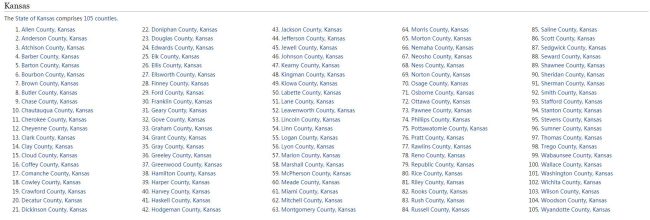Alabama is one of the 50 states of the United States of North America. The state is located in the Southern region of the US and has 4,802,740 inhabitants (2011). The capital is Montgomery and the standard abbreviation for the state is AL.
Alabama formally became the 22nd state of the United States of America on December 14, 1819.
The state is bordered by Tennessee to the north, Mississippi to the west, Georgia to the east and Florida to the south. Alabama is located in the southwest on the Gulf of Mexico.
The northeast of the state is located in the Appalachian Mountains. The highest point in Alabama is Cheaha Mountain with a height of 734 meters.
To the south, the state extends as far as the swampy Gulf Coastal Plain over fertile black-earth areas. This area is called the Black Belt.
Rivers and Lakes
The largest river in the state is the Alabama with a length of 500 kilometers. This river bisects the state from the northeast to the southwest.
Other major rivers include the Mobile, the Tensaw, the Tombigbee, Chattahoochee, Coosa, Tallapoosa, and the Tennessee.
The state has a large number of large lakes, such as Martin Lake and Lewis Smith Lake.
Agriculture
The primary arable crops for the state of Alabama are cotton, corn, soybeans and groundnuts.
Animal husbandry is mainly practiced in the Black Belt. This area used to be almost entirely occupied by cotton cultivation.
Climate and Vacation
Alabama has a humid, subtropical climate, with long warm summers and short mild winters.
Some tourist attractions in the state include Horseshoe Bend National Military Park, Mound State Park in Moundville, and Noccalula Falls near Gadsden.
Cities
The largest cities in Alabama are next to the capital Montgomery: Birmingham, Mobile, Huntsville, Tuscaloosa, Hoover, Dothan, Auburn, Decatur, Madison. See all cities and towns in Alabama.
- Birmingham: The Magic City
As Alabama’s largest city, Birmingham stands as a symbol of the state’s industrial prowess and cultural vibrancy. Known as the “Magic City” for its rapid growth in the late 19th century, Birmingham is a hub of commerce, education, and healthcare. With a rich Civil Rights history, it’s home to landmarks like the Birmingham Civil Rights Institute and the 16th Street Baptist Church.
- Montgomery: Capital of Dreams
Montgomery, the state capital, is steeped in history and tradition. As the birthplace of the Civil Rights Movement, it holds significant cultural importance. Visitors can explore historic sites such as the Rosa Parks Museum and the Dexter Avenue King Memorial Baptist Church. Montgomery also boasts a thriving arts scene and is home to the Alabama Shakespeare Festival.
- Mobile: Port City with Southern Charm
Nestled along the shores of the Gulf of Mexico, Mobile exudes Southern charm and hospitality. As one of the oldest cities in Alabama, it offers a blend of historic architecture, vibrant festivals, and delicious cuisine. The city’s Mardi Gras celebrations rival those of New Orleans, drawing visitors from far and wide. Mobile’s port serves as a vital economic engine for the region.
- Huntsville: Rocket City
Huntsville, known as the “Rocket City,” is synonymous with innovation and technology. As home to NASA’s Marshall Space Flight Center and the U.S. Space & Rocket Center, it plays a pivotal role in the nation’s aerospace industry. Huntsville’s thriving economy, fueled by research and development, attracts top talent from around the world. The city’s scenic beauty and outdoor recreational opportunities add to its allure.
- Tuscaloosa: Home of the Crimson Tide
Tuscaloosa, anchored by the University of Alabama, pulsates with energy and school spirit. Football fans flock to Bryant-Denny Stadium to cheer on the Crimson Tide, adding to the city’s electric atmosphere on game days. Beyond sports, Tuscaloosa offers a dynamic arts scene, picturesque riverfront, and a burgeoning culinary scene.
The Port of Mobile is one of the major seaports in the United States.
Alabama counties
The South American state of Alabama is divided into 67 counties.
Alabama
Alabama borders the states of Tennessee, Mississippi, Georgia and Florida. The state is located in the southwest on the Gulf of Mexico. The capital is Montgomery.
Trail Of Tears National Historic Trail
The original inhabitants of many areas of North America were the Cherokee Indians, whose culture was among the most advanced in America at the time. They subsisted on agriculture, hunting, and their culture was so high that they even had their own script. At the beginning of the 19th century, the Cherokees gained the status of a sovereign self-sufficient nation with their own rights and responsibilities.
However, in 1838, it was decided by President Andrew Jackson that these people would be evicted to Oklahoma. Of course, the Indians did not like this and refused to leave their homes and land. However, the government had already established a kind of “Indian territory” for them, to which it began to move this indigenous population against the will. This led to frequent battles, which unfortunately the Indians lost in most cases.
In the end, whether they wanted to or not, they all had to move and follow the route known as the Trail of Tears. More than 5,000 members of the tribe did not manage this difficult march to their new home. Every fifth Indian reportedly died during the trip. At the end of the journey, an unknown landscape awaited the survivors, an unknown country where everyone had to start from scratch. Some members of the Cherokee managed to escape to the mountains during transport, where they also found a new quiet place to live. Thanks to this inhuman act, the USA was able to take over more territory and significantly expand its country to the original Indian territories.
Today, this historic route is known as the Trail of Tears and is managed as a national monument. The route crosses nine U.S. states (Alabama, Arkansas, Georgia, Illinois, Kentucky, Missouri, North Carolina, Oklahoma and Tennessee) and is a reminder of the forced expulsion of Indians in the 19th century.




